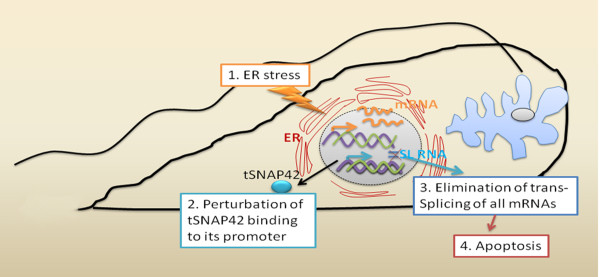Figure 2.
Representation of the ER stress induced Spliced Leader RNA Silencing pathway leading apoptosis in T. brucei. Trypanosomatid parasites share a gene expression mode which differs greatly from that of their human and insect hosts. In these unicellular eukaryotes, protein coding genes are transcribed polycistronically and individual mRNAs are processed from precursors by spliced leader (SL) trans-splicing and polyadenylation. In trans-splicing, the SL RNA is consumed through a transfer of its 5'-terminal part to the 5'-end of mRNAs. Since all mRNAs are trans-spliced, the parasites depend on strong and continuous SL RNA synthesis mediated by RNA polymerase II and transcription factors like tSNAP42. Upon prolonged ER stress (1. ER stress), the binding of tSNAP42 to its cognate promoter, the promoter element of the Spliced Leader RNA (SL RNA) is perturbed (2. Perturbation of tSNAP42 binding to its promoter). This leads to the shutting off of SL RNA transcription and the elimination of trans-splicing of all mRNAs (3. Elimination of trans-splicing of all mRNAs). The SL RNA silencing pathway finally induces apoptosis (4. Apoptosis).

